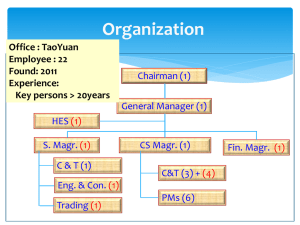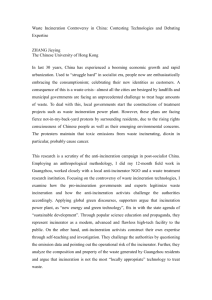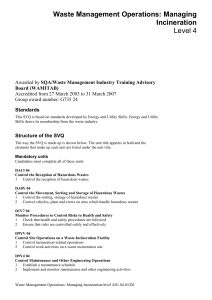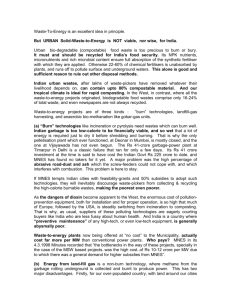Incineration-Vitrification of organic
advertisement
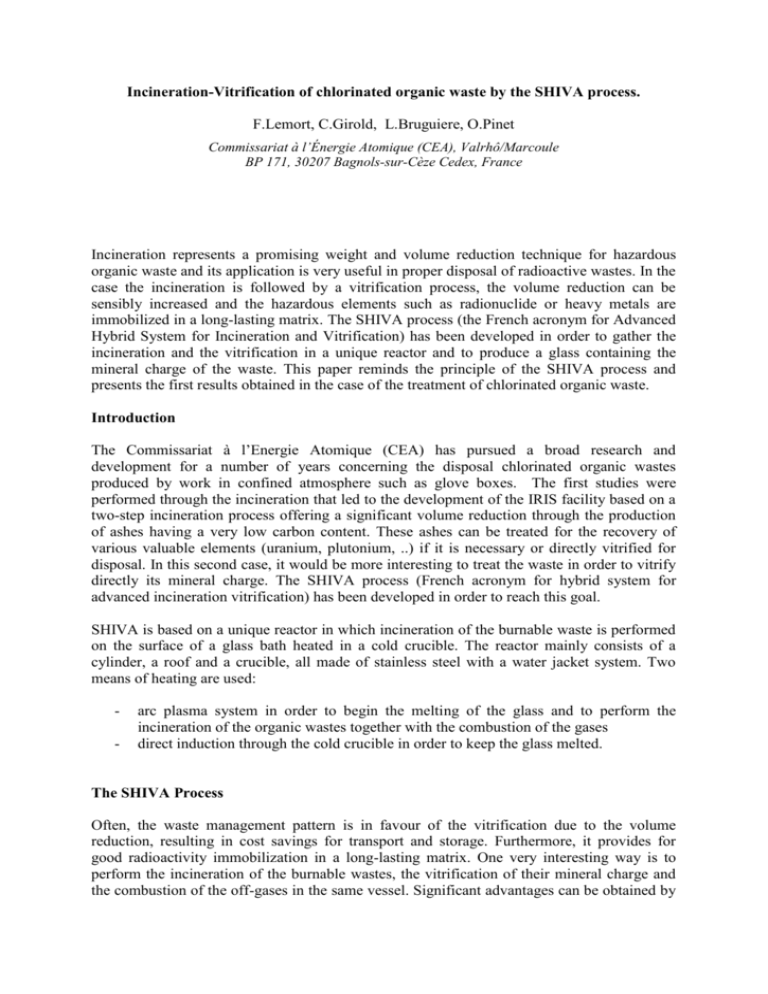
Incineration-Vitrification of chlorinated organic waste by the SHIVA process. F.Lemort, C.Girold, L.Bruguiere, O.Pinet Commissariat à l’Énergie Atomique (CEA), Valrhô/Marcoule BP 171, 30207 Bagnols-sur-Cèze Cedex, France Incineration represents a promising weight and volume reduction technique for hazardous organic waste and its application is very useful in proper disposal of radioactive wastes. In the case the incineration is followed by a vitrification process, the volume reduction can be sensibly increased and the hazardous elements such as radionuclide or heavy metals are immobilized in a long-lasting matrix. The SHIVA process (the French acronym for Advanced Hybrid System for Incineration and Vitrification) has been developed in order to gather the incineration and the vitrification in a unique reactor and to produce a glass containing the mineral charge of the waste. This paper reminds the principle of the SHIVA process and presents the first results obtained in the case of the treatment of chlorinated organic waste. Introduction The Commissariat à l’Energie Atomique (CEA) has pursued a broad research and development for a number of years concerning the disposal chlorinated organic wastes produced by work in confined atmosphere such as glove boxes. The first studies were performed through the incineration that led to the development of the IRIS facility based on a two-step incineration process offering a significant volume reduction through the production of ashes having a very low carbon content. These ashes can be treated for the recovery of various valuable elements (uranium, plutonium, ..) if it is necessary or directly vitrified for disposal. In this second case, it would be more interesting to treat the waste in order to vitrify directly its mineral charge. The SHIVA process (French acronym for hybrid system for advanced incineration vitrification) has been developed in order to reach this goal. SHIVA is based on a unique reactor in which incineration of the burnable waste is performed on the surface of a glass bath heated in a cold crucible. The reactor mainly consists of a cylinder, a roof and a crucible, all made of stainless steel with a water jacket system. Two means of heating are used: - arc plasma system in order to begin the melting of the glass and to perform the incineration of the organic wastes together with the combustion of the gases direct induction through the cold crucible in order to keep the glass melted. The SHIVA Process Often, the waste management pattern is in favour of the vitrification due to the volume reduction, resulting in cost savings for transport and storage. Furthermore, it provides for good radioactivity immobilization in a long-lasting matrix. One very interesting way is to perform the incineration of the burnable wastes, the vitrification of their mineral charge and the combustion of the off-gases in the same vessel. Significant advantages can be obtained by supplying the waste directly into oxygen arc plasma [1] located above a glass bath heated by direct induction in a cold crucible. The temperature is very high and so is the efficiency of the combustion in the exited free oxygen rich atmosphere that also promotes to a good oxidation of the glass. Figure 1 describes the reactor in which the incineration vitrification is performed. Waste + Glass precursor Ar/O2 Ar/O2 Cathode Anode Burned gases exhaust Metallic Cooled Plasma walls Molten glass Glass pouring HF Current Inductor Figure 1: Incineration vitrification reactor - Twin-torch transferred arc system The twin-torch transferred arc system comprises two plasma torches of opposite polarity. The cathode torch consists of a thoriated tungsten water cooled pointed electrode. Two water cooled nozzles, feeding argon and oxygen, provide a shroud of plasma forming gas around the cathode and confine the arc attachment to the cathode. The anode torch is similar to the cathode one, however the anodic electrode is a high-purity water cooled button of copper. - The Reactor The reactor mainly consists of a cylinder, a roof and a crucible, all made of stainless steel with a water jacket system. The inside diameter of the combustion chamber is 600 mm and the crucible diameter is 600 mm. The total height is about 800 mm. Two openings in the roof allow the entry of the twin plasma torches with an angle between them from 70 to 20°. Openings allow the feeding of the waste (solid and/or liquid) directly in the plasma zone. - The gas treatment The gas treatment is almost the same that for the IRIS process. It is made up of: o o o o A diluter leading to the cooling of the off-gas. An electrostatic filter A bag filter (to recover the last fraction of the dust) A scrubbing column The figure 2 gives a description of the whole process including the reactor followed by the gas treatment. Figure 2: Description of the SHIVA process - Operating Parameters For the treatment of each kind of waste, the crucible receives about 30kg of glass frit, which composition is to be chosen according to the kind of waste to be treated. The frit is first melted with the torches up to the moment when the quantity of melted glass is enough to ensure continued melting by induction. At this moment, the inductor is switched on to complete the melting of the glass bath. The temperature of the glass in the middle of the bath is held around 1200°C for an arc intensity of 200A and a voltage of 100V (this voltage increases up to 250V during feeding). The power of the high frequency generator (300 KHz) is maintained around 60kW. Then, the waste is processed by direct feeding in the plasma. As the plasma column radiation is very important, the waste generally ignites as early as it is introduced in the furnace and burns in the oxidizing atmosphere. With a moderate feeding flowrate of about 10 kg/h (depending on the waste), a perfect combustion is achieved in the oxygen plasma, on the surface of the bath, without accumulation. Glass pouring is possible after treatment. After each run, the products in each module of the installation are sampled and a material balance is made; it shows a good transfer in the glass of the mineral elements of the waste. The SHIVA process has a number of advantages: - Continuous feed of homogeneous waste and good combustion efficiency very compact process achieving the incineration and the vitrification of waste in a unique vessel the plasma torches allow to initiate the melting of the glass The cold crucible technology avoids the corrosion Production of glass that constitutes an ultimate disposal product with a maximal reduction volume…. The chlorinated organic wastes treatment The treatment of the wastes requires a specific preparation in order to be able to feed the reactor. To steps are necessary to reach the goal of the incineration-vitrification: The preparation of the load The feeding The incineration-vitrification In addition, it is interesting to performed the phosphation of the dust as it has been made regarding the incineration by the IRIS process. Composition of the waste and phosphatation Incineration-vitrification tests were performed on technological wastes with a mean composition representative of the actual waste stream, comprising 10 wt% cellulose, 8% polyethylene, 17% neoprene, 17% latex, and 48% PVC. The feed rate was about 3 kg·h-1. Phosphorus that is introduced together with pink PVC is used to convert the chlorides to phosphates as it has been performed in incineration processes (IRIS) [2] The composition of the blended waste stream was analyzed, and the main elements are indicated in Table 1. Phosphorus was not present in sufficient quantities for zinc phosphatation, as it accounted for only 0.05 wt% of the waste feed. The values in the table are only averages for multiple waste batches. The “other” column (0.7 wt%) includes a variety of minor elements (Na, Mg, Cr, etc.). Element C H N O Cl S K Ca Zn Al Si P Other wt% 57.9 7.8 0.3 9.3 22.2 0.4 0.1 0.2 0.6 0.2 0.3 0.6 0.7 Table 1: Waste feed stream composition (wt%) The test that was previously performed about the incineration of the wastes through the IRIS process showed that the ash composition [3] was largely constant but that phosphatation occurred in the afterburner [4] leading to obtain very stable dust. The table 2 gives the composition of the dusts that are obtained without and with phosphorus addition. Element Zn Cl P C Si Al Ca K Without P additive 47.4 51.4 0.3 0.1 0.2 0.1 0.1 - With P additive 26.9 0.2 24.9 0.2 0.1 0 0 4.2 Table 2: Particle matter composition (wt%) In heat treated wastes without phosphorus additives, zinc was found exclusively as zinc chloride (ZnCl2 constituted about 99 wt% of the particle matter); the analysis results without P additive in Table II account for virtually all the material weight. Conversely, the results obtained with the Phosphorus additive reveal a major weight deficit due the fact that oxygen was not analyzed: phosphorus was found mainly as phosphate, and oxygen could account for over 40 wt% of the particle matter. Although the analyses were performed using different protocols with different material batches, and some caution is necessary in comparing the results, the effectiveness of the phosphorus additive is indisputable: the chloride content was reduced to virtually to zero. A qualitative comparison of the particle matter confirmed this observation: the particles became liquid and highly corrosive in air in the first case, but remained dry and stable in the second. The experience acquired about the incineration has to be used on SHIVA in order to transform the chlorides into phosphates and then to protect the facility. Then, phosphorus was also added through the pink PVC in the same proportion. Preparation of the load The wastes coming from the gloves boxes are made of different kind of plastics and metals and the mixture has to be prepared before treatment. The first operation consists to sort the mixture in order to separate the plastics and metals. This can be performed manually or thanks to an X-ray inspection. Then, a shredding of the first components lead to obtain thin fragment that are brought up to an homogenizer. Downstream, the waste is sent up to the feeding hopper before being introduced into the process. This kind of preparation has been previously tested for the incineration of the waste and is implemented at the valduc centre for the industrial application of the alpha incinerator. In addition to the previous description, an automatic extraction of small metal parts has been implemented in this facility to prevent dysfonctionement The feeding The introduction of the waste is performed thanks to a screw connected to a feeding hopper ensuring a continuous and steady feeding rate. The regulation is carried out with weight sensor inducing the speed of the screw. By this way, the waste drops directly in the plasma. The waste treatment A first experiment was carried out during height hours. The following table summarises the main running parameters record during the treatment. Parameter Feeding rate Plasma torches HF generator Electrostatic precipitator Gas A V O2 Ar P F Ui Uf CO NOx Value 3 kg.h-1 220A 230V 10NM3.h-1 5.5NM3.h-1 100kW 283Hz 65kV 40kV < 100 ppm < 1000ppm Table 3: Main running parameters of the SHIVA process (Ui: initial value, Uf: final value) The main results The observations performed during the treatment show clearly a good behaviour of the process with parameters remaining steady. The only technological difficulty occurs on the introduction of the waste with the appearance of periodic clogging. Some improvements are going to be made to ensure a very continuous feeding. After the experiment, some deposits were removed from the facility. The following table gives their amount for the treatment of 33kg of wastes: Location of Weight (g) Weight % of deposits initial load Reactor 930 2.8 Connexion to 500 1.5 filter Cold point 30 0.1 Filter 1041 3.15 Table 4: Amount of deposits removed from the facility The cold point is located directly under the inlet of the diluter. At this place, the deposits are liquids. Some analyses have been performed on each of these deposits. The table 5 gives the results. Element Reactor Connexion Filter Cold point 1.55 1.3 1 0.64 C 18.4 30.5 26 38 Cl 1.4 0.53 0.62 0.63 S 4.6 5.1 11.5 2.15 P 6 3.75 9.5 2.95 Na 2 1.75 3.25 0.55 K 1.25 0.35 0.25 0.3 Mg 6.2 3.6 1.25 1.05 Ca 18.5 15.6 20 3.8 Zn 16.5 3.6 1.9 1.6 Al 4.3 2.1 1.9 1.25 Si 0.9 1.4 1.5 Sb 1.3 3 0.1 2.9 Ni 6.4 15.9 1.1 26 Fe 1.6 3.4 0.15 5.8 Cr 1.6 0.75 0.25 0.15 Ba 1.45 1.45 3.1 1.96 B 4.8 4.2 15.7 8.9 O Table 5: Analysis (weight %) of the deposits coming from the different locations The analysis of the glass has not been performed. The main conclusion coming from the results indicated in Table 3 are: - All the deposits have low carbon content. The combustion of the waste is the totally achieved. - The deposits contain phosphorus and essentially the dust removed from the filter. This shows the feasibility of the phosphatation. - The deposits have high chlorine content even in the filter. The phosphatation of the dust is not totally achieved. Despite of this observation, the dust containing around 26% weight has a good behaviour (remain dry). - All the deposits contain boron that comes from the volatilisation of the glass and essentially during the melting of the glass. - The composition of the liquid deposits removed from the cold point shows corrosion products (Fe-Ni-Cr). According to the table 4, the amount of the dusts represents around 7% of the initial load made up of 75% of CHON that are transformed into gases. This suggests that if all the dust comes from the waste, the mineral charge of the 33kg of waste representing 8250 g of dust is introduced in the glass with an efficiency of around 70%. By considering that a part of the dust comes from the volatilisation of the glass (B in table 5), this amount could be a minimum. In addition, in the case it will be possible to recycle the dust recovered from the filter in a colder area of the glass, this efficiency could be sensibly increased. All these observations show a feasibility for the treatment of organics chlorinated wastes by the SHIVA process. However, some improvements have to be made in order to enhance the phosphatation of the dust and to eliminate cold point in the connexion between the reactor and the filter. References [1] C.Girold, R.Cartier, J.P.Taupiac, J.M. Baronnet Incineration/vitrification of surrogate radioactive wastes under transferred arc plasma Waste Solidification-Stabilisation Processes,1995, Nancy, France [2] F.lemort, JP.Charvillat Incineration of chlorinated organic nuclear waste: in situ substitution of phosphates for chlorides, ICEM 99 Conference, September 26-30, 1999, Nagoya, Japan [3] A.Jouan, JP.Moncouyoux, R.Boen, R.Cartier, JJ.Vincent and T.Longuet Incineration Processes for Radioactive Waste with High Alpha Contamination: New Development. Proceeding of IT3 Conference pp. 209-210, May 8-12, 1995, Bellevue, Washington, USA. [4] H.Rouault, R.Cartier, R.Boen, T.Longuet Phosphorus: In situ Treatment for ZnCl2 Formed by Incineration of Organic Waste. Proceedings of IT3 Conference, pp. 225-228, May 11-15, 1998, Salt Lake City, Utah, USA.

